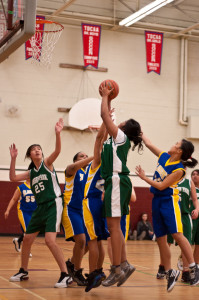Deciding when to Trigger Post Help Defence Rotations
Selecting the right type of Post Help Defence strategy to have can greatly help with a team’s ability to deal with a superior or significant opposition post player. Having a defined post strategy going into a game can help deal with potential issues and limit the ability for your opposition to execute a vital part of their offense. Better than this situation however is the ability to have a number of tactics to deal with issues caused by opposition post players. How to guard the post is one aspect, how help defence will react, is another that helps in limiting the options on offense for your opposition.
A very common problem experienced by coaches on a regular basis is not being aware of the possible options that can be selected for their help defence when dealing with limiting the post output. Further complicating this situation is deciding when help defence should be released and reasons why you select one strategy or another. Getting the right initial defence and help defence rotations correct will eliminate the increased chances of offensive players taking advantage of your defence and having a career night.

There are three options to consider for a coach when deciding when to trigger help defence rotations into the post situation. These are:
- Denial
- On the Catch
- On the Dribble
Selecting the right option is specific to the individual offensive player. No one technique is perfect and all have limitations in certain scenarios. The important point to note, is matching the right post defensive strategy with each specific offensive post player. Having the ability to interchange between the options though will lead the best flexibility within your team and increase the overall chance of success. Remember for ever strategy that you implement your opposing coach with be doing the same to create offensive opportunity for their players. It makes sense then that having different defensive strategies will allow your team to counter change-ups in your oppositions play.
Denial has been included here even though it’s primary focus is often described by the player match-up rather than the help defence rotation timing. However it will be included here as it has an effect on both the primary defender and defensive rotations as a whole. In the denial defence the help rotation should be placed between the split line and the offensive post player. In this situation the help defence can contest the pass or collapse onto the post player once they catch the ball. The denial defence while effective can create significant vulnerabilities in other rotations within your defence so look to use this option as a change-up.
The second option is for the help defence to be activated On the Catch by the Post Player. This type of strategy is undertaken when the post player is excessively quick on the dribble or if their post moves are short in time of execution. For example of your oppositions post player has a go to move which requires a very short period of time (one dribble and into shot) with the ball in their possession, being able to trigger the help defence rotation at this point is a must.
The third option focusing on the timing of the help defence rotation is On the Dribble by the Post Player. This option can be utilised when the post player is slow enough on the dribble to allow for adequate defensive rotations to happen and provide satisfactory defensive pressure. To add more time between the rotation and a possible reaction by the offensive player the help defence should look to react as soon as the ball leave the hand for the dribble.
These options rely on timing and so your team’s defensive awareness needs to be refined to the point that they can make the read and react with enough intensity to get the job done. Rotating on the catch won’t work if the help defender is slow or does not see the ball to react to the situation.






Leave a Reply